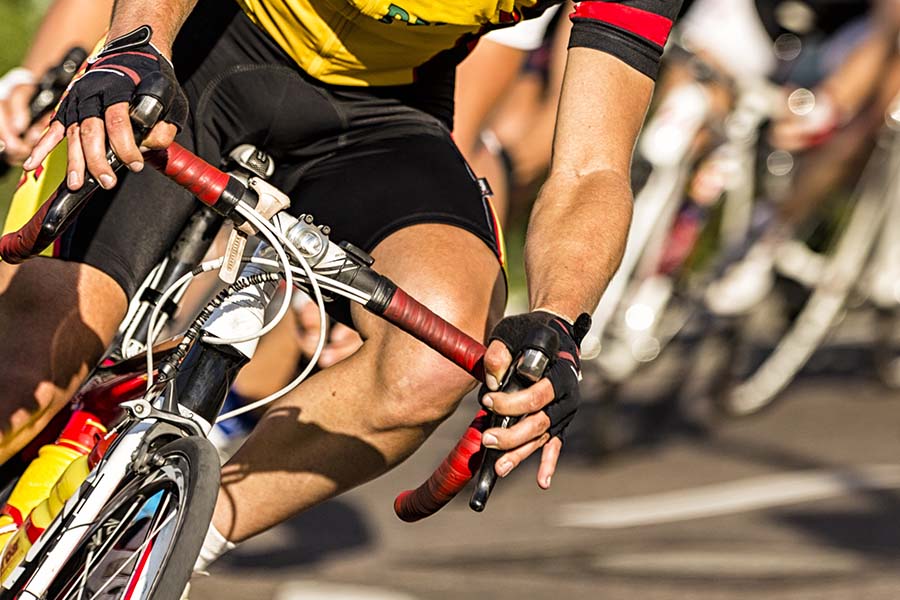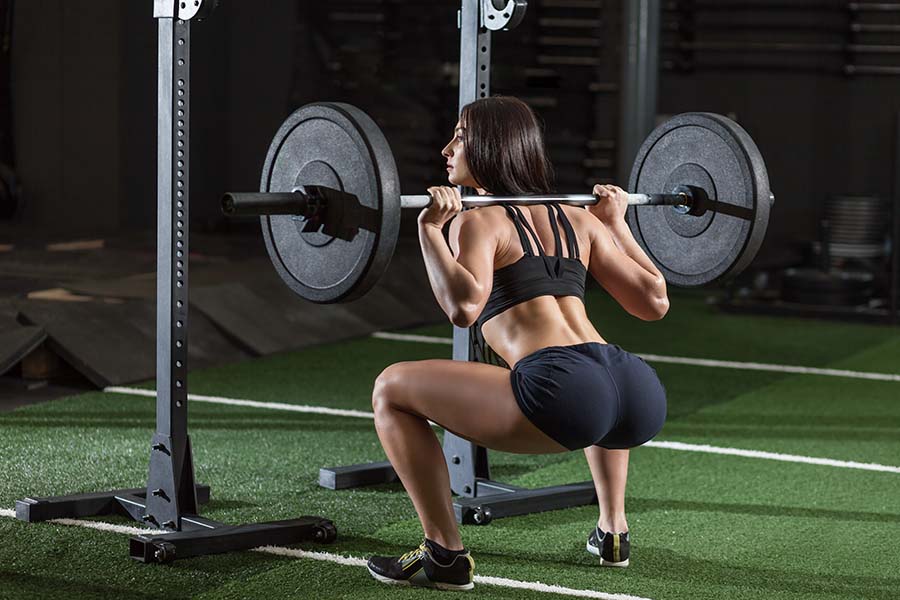The squat is an effective full-body workout that helps you build strength and muscle while burning calories. This exercise strengthens your core and the entire lower body, making it an ideal choice for anyone looking to strengthen and tone their body.
But specifically, what muscle groups do squats work? The answer to this question is that since squats involve more than just the leg muscles, they work the calves, abdominals, and lower back muscles to some degree.
In a nutshell, Squats might have benefits, but if you're looking to bulk up those calves - they probably are not your best bet. Let us delve into the world of calves and find the best exercises that center the calf muscles to achieve optimal results.
Why Do Squats Don't Work Your Calves?
Looking to give your calves some extra love? Squats might help, but they won't cut it if serious calf-building is what you're after. To make an impact in building solid and mighty calves, add boxing, cycling, jump roping (no one said sculpting was easy), box jumps, or old-school weighted calf raises to your routine.
Further, research has found that when you don't perform squats correctly, your calves are under more strain than necessary. It can be dangerous and you could potentially injure your knees and lower back. Furthermore, it reduces the efficacy of the exercise as squats are meant to target the quads, hamstrings, and glutes, not the calves.
As a result, squats cannot be considered an effective calf-building exercise. Suppose you want to target the calves more effectively and safely. In that case, selecting exercises performed correctly and precisely designed to strengthen the calf muscles is essential.
The Best Calf Exercises
The glutes, quads, and hamstrings get a lot of attention regarding lower-body workouts - it's time to pay attention to your calves! If you want to beef up your calves, step away from the squat rack and try these five exercises instead! From leg presses to heel raises, give each move a go and watch as those calf muscles become more toned than ever.
Adding these non-squat exercises to the mix can give those underappreciated muscles extra love. So pick an exercise from this list that fits you, and happy calf flexing! Let's add some variety to your lower body workout for the best results - we guarantee it'll be worth it!
- Calf raises
- Lunges
- Jump Rope
- Cycling
- Box Jump
- Box Squat with Kettlebell
Related Article: Why Ankle Straps are The Best Choice for Lower Body Perfection
Calf Raises

Calf raises are a type of exercise that targets the muscles in the lower leg, specifically the calf muscles. This exercise is a simple and effective way to strengthen and build muscle in the calves. It is usually done standing but also sitting, with or without weights.
Benefits of building calves
Calf raises with neoprene dumbbells can help you develop and strengthen the calf muscles. They can help build muscle and strength in the calves when done with weights. It can improve athletic performance and reduce the risk of injury. In addition, they can improve balance, coordination, and stability.
How to do it
To do a calf raise
- Stand with your feet hip-width apart, then slowly raise your heels, squeezing the calf muscles.
- Hold for a few seconds, then lower your heels back down.
- Do 10-15 repetitions for two to three sets. Make sure to rest for about 30 seconds between sets.
- Beginners should start with body weight only; as you become stronger, you can add weights.
Lunges

Lunges are one of the most popular lower body exercises used to tone and strengthen the lower body, specifically the muscles in the legs, glutes, and calves. Lunges target different muscle groups in the lower body and can be performed with or without weights. When performing a lunge, the calf muscles push off the ground and propel the body forward. This pushing action helps to strengthen and tone the calf muscles.
Benefits
Regularly performing lunges can improve your lower body strength, muscular endurance, balance, and stability. Lunges are a great exercise to add to your lower body routine and help build solid, toned calf muscles. Lunges are beneficial in building the calf muscles as they are a compound exercise that works the entire leg. If you add resistance bands while performing lunges, it can double-fold the results.
How to do it
When performing a lunges
- Stand with your feet hip-width apart and take a significant step forward. Lower your back knee to the ground while keeping your front knee above your ankle.
- Keep your chest and head up and your core engaged throughout the exercise. Push through your front heel to stand up and bring your back leg forward to begin the next rep.
- An ideal number of repetitions for a lunge is 10-15 reps per leg. It can be increased or decreased depending on the individual's fitness level. Beginners should start with 10 reps per leg and gradually increase the number of reps as they become stronger.
Jump Rope

Jump rope is one of the most accessible cardiovascular exercises and a fantastic way to build muscular strength and endurance. Since it is a low-impact exercise that can be performed almost anywhere and tailored to any fitness level, jump ropes come in various sizes, materials, and styles. Besides that, the handles can be adjusted to fit any hand size.
Benefits
Jump ropes are a great way to build calves. Regularly performing jump rope exercises can strengthen and tone the muscles in your calves. Jumping rope is also a great way to burn fat and calories, which can help you lose weight and tone up your calves.
How to do it
To perform a jump rope exercise
- You can start with a light rope and adjust the handles to fit your hands. Stand with your feet hip-width apart and hold the rope's handles.
- Jump over the rope one foot at a time, taking care to land lightly on the balls of your feet.
- The number of repetitions you should do depends on your fitness level and goals. Beginners should aim for 20-30 repetitions, while more experienced jumpers can do up to 100 repetitions.
Cycling

Cycling is a form of exercise that uses a bicycle as a form of transport or exercise. Cycling is a low-impact, low-intensity exercise suitable for people of all ages and fitness levels and can be done outdoors or indoors. Cycling is a fantastic way to stay fit, reduce stress, and improve overall health.
Benefits
Cycling is an excellent way to strengthen and build your calves. The calf muscles are used when pedaling the bike, and the resistance from the pedal provides enough tension to build the muscle. Cycling works your calf muscles differently from walking or running, providing a unique challenge for your muscles.
How to do it
When it comes to performing cycling for building calves, it is essential to
- Keep your cadence (pedaling rate) consistent and focus on the upstroke. Keep pedaling in a circle, pushing up and down with your legs.
- Focus on pushing with your toes, as this can help to build the calf muscles.
- Regarding the number of repetitions, start with 15 minutes of a ride at a time and gradually increase the time as your body gets used to the exercise. After a few weeks, you can increase the intensity by increasing your ride's distance and speed.
Box Jump

Box jumps are a plyometric exercise that targets the lower body, involving jumping onto and off a box or platform. When performing box jumps, the calf muscles help propel the body onto and off the box and absorb the landing force. Box jumps are a great way to increase an athlete's vertical jump, which is essential for many sports. They can also be used as a high-intensity cardio workout.
Benefit
Box jumps are excellent for building strength and power in the calves and increasing muscular endurance. Box jumps can help build explosive power, balance, and coordination and strengthen the calves, hamstrings, and glutes. It can help increase the calves size, strength, and endurance. Incorporate box jumps into your lower body workout routine to get the most out of this exercise. Use proper form to avoid injury and get the most out of the exercise.
How to do it
To perform box jumps
- Stand before a box or platform with feet slightly wider than shoulder-width apart. Bend the knees and hips, then explosively jump up onto the box.
- Once on the box, land softly and quickly jump back off. Avoid pausing on the box, as this can reduce the intensity of the exercise.
- Aim for 3-5 sets of 8-12 repetitions or as tolerated. Rest for 30-60 seconds between sets.
Box Squat With Kettlebell

Box Squats with Kettlebells are an effective way to build and strengthen your calves. It is a variation of the traditional box squat; an essential squat exercise is done with a box or bench behind you. Instead of a barbell, this version of the box squat is done with two kettlebells. The kettlebells are held in each hand to help you squat. The kettlebells provide an additional challenge and can help to target the muscles in your calves.
Benefits
The benefits of box squats with kettlebells include building and strengthening the calves, improving balance and stability, and helping to increase power. Because the kettlebells provide an additional challenge, they can also help to build muscle mass. Additionally, this exercise can improve your flexibility and coordination.
How to do it
To perform Kettlebell Squats
- Start with a lightweight, such as two 10-pound kettlebells. Once you are comfortable with the exercise, you can gradually increase your weight.
- When performing the exercise, keeping your back and core muscles tight and planting your feet firmly on the ground and your chest up is essential.
- The number of repetitions for the box squat with kettlebells depends on your fitness level and goals. You can start with 12-15 repetitions. As you become more comfortable with the exercise, you can gradually increase the number of repetitions.
Related Article: Maximize Your Post-Workout Benefits with These 10 Tips
FAQs
1. Do squats work, abs?
Yes, squats do work your abs. Squats are a compound exercise that targets multiple muscles simultaneously, including the core abdominal area. When you do squats, you engage your abdominals and other major muscle groups, like the quads and glutes, to stabilize you as you move.
2. Do squats work hamstrings?
Yes, but you must ensure that you are correctly engaging your hamstring muscles when performing a squat; you must widen your stance so that it is slightly wider than shoulder-width apart; keep an upright back position by bracing through your core, and make sure to push through the heels during each rep.
3. Do deadlifts work calves?
Yes, deadlifts do work your calves. Deadlifts are a compound, full-body exercise involving the legs major muscle groups. Specifically, your calves (or calf muscles) are engaged during a proper deadlift's lifting and lowering phases.
4. Do squats work glutes?
Absolutely! Squats are the best for your glutes as they target these muscles specifically. Squats work a range of muscles in the lower body, including your quadriceps, hamstrings, and calves, but they also emphasize the gluteal muscle group.
The Bottom Line
Squats are a practical option if you're looking for a full-body workout that strengthens the core and lower body. However, they need to target calves more effectively to build calf muscles. Rather than relying solely on squats, add box jumps, jump rope exercises, cycling, lunge exercises, or calf raises to your routine. By doing so, you'll be well on your way to building solid calves without doing multiple reps of traditional squats. And this article covered all this for you. So, go and get those pesky calves fixed and get the best out of them.
Reading List
10 Dumbbell Exercises for Stronger Legs Without Going to the Gym
Tips for Stronger & Defined Legs
The Science of Muscle Recovery: How Much Rest Between Workouts for Muscle Growth?
Article Sources
- Slater, Lindsay V., and Joseph M. Hart. "Muscle Activation Patterns During Different Squat Techniques". Journal of Strength and Conditioning Research, vol. 31, no. 3, Mar. 2017, pp. 667 - 76. IngentaConnect, https://doi.org/10.1519/JSC.0000000000001323











